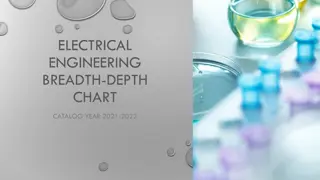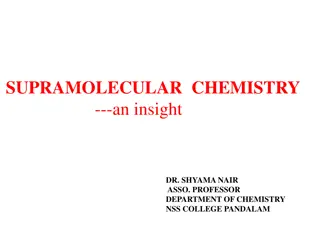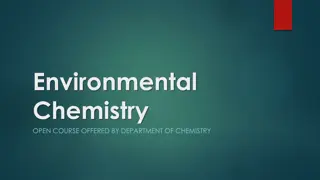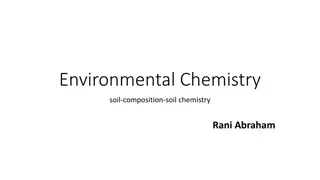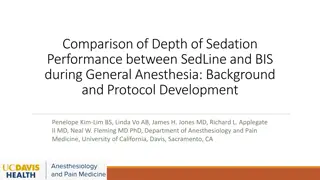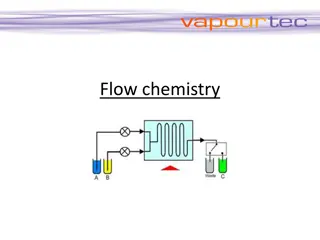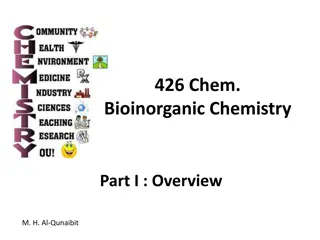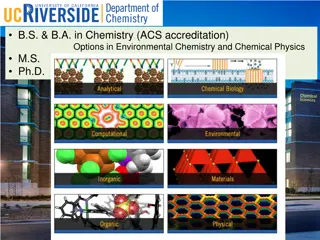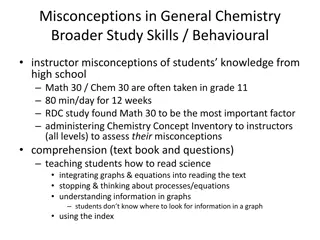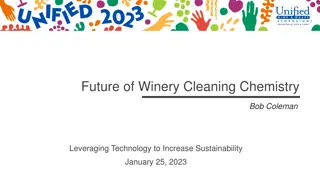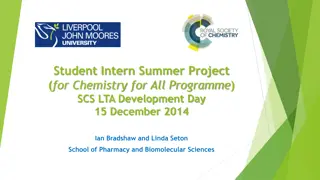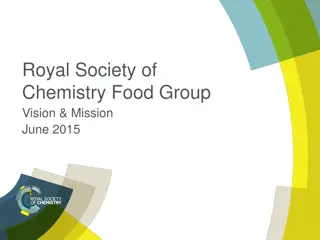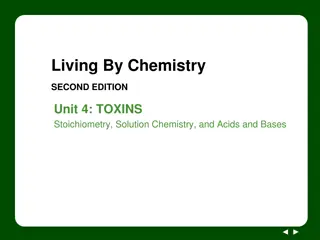Chemistry Lecture Series for In-Depth Learning
Unveil the intricacies of Chemical 253.5/6 lecture series, exploring fundamental concepts and practical applications in the realm of Chemistry. Delve into a comprehensive study of key topics, enhancing your knowledge base and theoretical understanding. Dive into the world of chemical reactions, structures, and mechanisms, guided by experienced educators to elevate your proficiency in this dynamic discipline. Equip yourself with the tools to excel in academic pursuits and real-world scenarios through engaging and informative sessions on the principles of Chemistry.
Download Presentation

Please find below an Image/Link to download the presentation.
The content on the website is provided AS IS for your information and personal use only. It may not be sold, licensed, or shared on other websites without obtaining consent from the author.If you encounter any issues during the download, it is possible that the publisher has removed the file from their server.
You are allowed to download the files provided on this website for personal or commercial use, subject to the condition that they are used lawfully. All files are the property of their respective owners.
The content on the website is provided AS IS for your information and personal use only. It may not be sold, licensed, or shared on other websites without obtaining consent from the author.
E N D
Presentation Transcript
Announcements Return HW and Group Assignments Turn in Green Chemistry HW Today s Group Assignment mostly on Green Chemistry Today: completion of Biofuels and then on Toxicology (some part will be covered next week) Reading for Toxicology - Girard, Principles of Environmental Chemistry, 2ndEdition Chapter 16; photocopy placed in folder in main office Homework Questions Posted (Subset 3.4 only 3 to turn in) Last Lecture + Group Assignment Next Week Will Have some time to Review for Final Exam
Green Chemistry - Review Rationale Improved design of compounds involving increased efficiency, less waste of resources including energy, and decreased toxicity Can also be applied to new product production (e.g. pesticide examples) Main Principles: See 12 Principles Atom Economy: % atom economy = (molar mass of atoms utilized/total molar mass of all reactants)*100 Hazard Assessment (will get to this more later today)
Green Chemistry - Review Changes Resulting in Improvements More effective products (narrowly targeted pesticide examples) Solvents (move from VOCs to water-based, HFCs, CO2, or ionic liquids) Use of Renewable Feedstocks (e.g. from petroleum based to plant based) Energy Requirements (lower temperatures or more efficient heating) Other Methods of Reducing Waste (the three Rs: recovery, reuse/recycle, regenerate)
Energy Use and Fuels - Biofuels - Overview Main Rationale for Use Q. While all carbon-based fuels will release CO2, what is the advantage with respect to controlling CO2concentrations to using a bio-based fuel? A. The main advantage is if the carbon originates from plant material, when plants regrow, they will reabsorb emitted CO2. In principle, this would mean there is no net CO2production. Limits to Use Plants fix carbon dioxide using sunlight to produce organic compounds CO2+ H2O CH2O (biomass) + O2(unbalanced) The above reaction converts sunlight to chemical energy, but is not super efficient (power density = 0.6 W m-2) A very significant fraction of the Earth s surface would need to be devoted to biofuel needs to meet total transportation demand
Energy Use and Fuels Biofuels - Overview Main Types Direct use Fuels: Combustion of wood for heating, cooking or electricity production Limited Practical Use (due to pollution and limited resources) Sugar Based Fuels (main base unit = glucose) Ethanol from Sugar Ethanol from Starch Ethanol from Cellulose Related fuels Lipid Based Fuels Direct use of oils Biodiesel O OH O OH OH HO OH O R R O H3 C OH O- O H3 C O + R' O + OH R' O H3 C R" O O + OH O R" O H3 C O
Energy Use and Fuels Biofuels - Overview Secondary Advantages Oxygen Content A small increase in oxygen content (especially in petroleum/biofuel blends) improves combustion and reduces pollutants (e.g. CO) Although, this reduces energy density (carbon is already partially oxidized) Reduction in Toxicity Biofuels start with reduced sulfur, fewer aromatics than diesel and gasoline A fraction of fuel source is waste material (e.g. used cooking oil) or has co-generation products Some of these advantages are good when use is low
Biofuels - Sugar Based Fuels Ethanol as a Fuel It can easily be added to gasoline (good oxygenate and octane booster, but requires fuel reformulation ) Harder to use at higher concentrations Additional disadvantages from lower energy density and from ability to absorb water Ethanol Production from sugars and starches Technology for producing ethanol has been around for a long time Once small sugars (mono- or di-saccharides) are present, yeast enzymes convert sugars to ethanol in water (with carbon dioxide as waste product) This results in ~10 to 15% ethanol maximum (yeast don t tolerate higher ethanol conditions)
Biofuels - Sugar Based Fuels cont. Ethanol Production from sugars and starches Besides application to sugar cane/sugar beets (sucrose feedstock), it is easily applied to starch sources (source for many alcoholic beverages) using other enzymes to depolymerize starch A major inefficiency in ethanol production is in separating ethanol from water (distillation requires energy), although production from sugarcane is more efficient than production from corn Due to inefficiencies in harvesting and processing, ethanol production is barely beneficial in reduction of greenhouse gases (and may be harmful if considering N2O production)
Biofuels - Sugar Based Compound Ethanol Production from cellulose Because sugar and starch have food value, there is a competitive disadvantage to using theses sources for fuels Much of harvested plant waste (e.g. corn cobs) is cellulose Depolymerization of cellulose is more difficult Technology (enzymatic or acid catalyzed) for converting cellulose into sugar is still maturing Related Fuels Besides yeast, other organisms can convert sugar into better fuels (e.g. butanol worse to drink but better alone or with gasoline)
Biofuels - Lipid Based Fuels Vegetable Oil and Meat Fat as a Source Fats (triglycerides) are high energy content fuels (used for long term fuel storage in organisms) Oils can be used directly as fuel, but have low volatility More common use is through conversion to biodiesel (typically methyl esters of fatty acids) Besides transesterification, production also involves clean up to remove unreacted constituents, waste glycerin, and other contaminants Overall energy required for fuel production is lower than for ethanol from sugars
Biofuels - Lipid Based Fuels Biodiesel as a Fuel In many regards, biodiesel is a cleaner burning fuel (lower particulates, low volatility) The one exception is NOX formation (higher in biodiesel) The other issues are fuel stability (oxidation from unsaturated fatty acids, while saturated fatty acids precipitate easily) and effects of contaminants and aged fuel on engines As with ethanol, blends generally are less problematic
Biofuels Renewable Fuels Using Fischer-Tropsch Process I know about this through a contract with Greyrock Energy (Sacramento-Based Fuel Company) Fuel production is through a two step process First step is heating biomass under reduced oxygen: CH2O (biomass) CO + H2 Then, the CO and H2 recombine with catalysts making CH2 radicals (and H2O). Depending on catalysts and conditions, products can range from methanol to synthetic gasoline to synthetic diesel
Biofuels Renewable Fuels Using Fischer-Tropsch Process Example chromatograph from synthetic diesel (top) vs. petroleum diesel (bottom) FID1 B, (TODD\11121303.D) 1.814 6.725 8.233 9.539 10.709 pA 100 Area: 137.09 Area: 136.165 4.972 Area: 110.505 12.775 2.126 Area: 133.629 11.779 3.210 80 13.727 Most tall peaks are linear alkanes Area: 78.0169 Area: 80.6666 14.671 Area: 74.3084 4.815 2.707 Area: 64.1605 16.561 1.704 60 6.587 3.085 15.613 Area: 47.3693 2.075 Area: 47.2415 Area: 48.5174 8.114 Area: 43.2102 17.511 40 Area: 37.8455 4.149 18.455 Area: 30.7745 19.389 9.436 Area: 18.9719 10.875 Area: 22.5431 Area: 24.009 Area: 14.1387 Area: 18.4029 Area: 14.9034 20.304 Area: 11.2183 10.617 10.766 21.198 Area: 14.382 Area: 8.32839 22.067 Area: 5.67164 26.373 22.909 Area: 7.04175 Area: 9.11661 23.727 26.030 24.520 11.697 25.287 20 7.819 9.175 2.942 10.384 6.249 12.701 11.829 12.821 8.314 2.177 9.604 1.544 6.828 5.103 11.493 3.334 6.956 8.432 2.248 9.716 5.249 3.468 4.459 0 0 5 10 15 20 25 min FID1 B, (YVONNE\08211302.D) 1.795 1.820 4.177 10.732 pA 9.563 11.803 12.801 50 13.755 14.700 40 15.645 10.889 8.257 11.522 16.596 12.579 30 10.320 17.547 9.778 9.062 9.149 9.200 2.965 13.400 10.404 10.446 10.070 10.262 18.494 19.429 10.520 10.625 12.222 12.313 8.571 11.578 11.747 11.218 6.752 10.683 11.993 11.326 20.346 11.425 15.705 9.984 11.376 15.164 11.075 12.133 12.393 11.877 12.520 8.637 8.725 9.402 12.891 10.811 9.896 10.030 21.241 8.132 8.200 12.444 16.696 20 10.980 11.138 22.111 9.112 11.685 11.033 22.956 9.668 11.918 7.710 7.846 13.328 9.451 9.604 8.988 14.309 14.199 7.747 7.916 7.290 7.380 14.256 14.355 9.328 13.840 8.790 8.903 8.035 8.607 8.841 8.453 8.871 7.629 8.515 6.542 7.232 6.249 8.076 6.280 5.917 8.410 5.655 6.862 6.158 6.646 7.067 4.584 10 0 5 10 15 20 25 min
Biofuels Questions I 1. List one advantage to biofuels other than reduction of CO2 emissions. Why is it better to think of biofuels as useful for a reduction in as opposed to a replacement of petroleum fuels? If lipids and carbohydrates can be used to produce fuel, why not proteins? 2. 3.
Biofuels Questions II 4. The stoichiometry for ethanol combustion is: C2H6O + 3O2 2CO2 + 3H2O. What does this say about energy efficiency (by comparing to fossil fuels)? Although ethanol production from cellulose is not currently cost effective, why is it considered advantageous to producing ethanol from starch? Air pollution control districts often have summer fuel blends to reduce ozone production. Why might there be more restrictions on biodiesel use in the summer? 5. 6.
Toxicology - Overview A. Exposure B. Dose/Response C. Fate of Toxic Substances in the Body D. Types of Effects to cover later
Toxicology - Exposure The degree to which a toxic substance will cause health problems will depend on the following conditions: Concentration of substance Form of substance Route of entry to body Time period in which body is exposed Body s reaction to toxic substance (only above are considered exposure)
Toxicology - Exposure Form of substance: - The form of the substance will affect how toxic compounds pass through barriers (skin, GI tract, airways) Some examples: - mercury (methyl mercury vs. inorganic mercury) - aerosol particles (coarse vs. fine; acidic vs. neutral) - compounds in specific solvents (e.g. dimethylsulfoxide vs. water) Any form that makes barrier passage easier increases toxicity
Toxicology - Exposure Routes of exposure 1. Percutaneous (through skin) basis: - diffusion (pure compounds) very fast for gases; very slow for solids; faster for smaller molecules - polarity (faster for non-polar compounds) - solvent effects (solutes in certain solvents like DMSO and acetonitrile have increased hazards) - people with dermatitis or abrasions are affected at lower concentrations Examples: Worker retrieving tool dropped in vat, contact with pesticides when harvesting crops
Toxicology - Exposure 2. Inhalation - gases diffuse to surfaces (reversible absorption) - water soluble gases tend to be absorbed more efficiently but often before the lungs - lungs tend to be most sensitive organ of airways (large surface area and designed for diffusion to blood). - Effects can be felt quickly
Toxicology - Exposure Inhalation (continued) - aerosol particles tend to deposit on surfaces irreversibly - coarse particles can t follow bends; fine particles go to lungs; ultra-fine particles diffuse to surfaces Air passage Mean gas trajectory Gas or ultra- fine particle Particle trajectory Random motion brings ultra-fine particle to wall
Toxicology - Exposure (Inhalation) Airways have defense mechanisms (mucous and cilia to remove particles) Toxic response can be due to passage to blood and rest of body (pulmonary problems) or to lung cell damage (e.g. asbestos) People with asthma can suffer at much lower doses than others Respiration affects exposure. Heavy work or exercise in poor air quality can be harmful.
Toxicology - Exposure 3. Oral - Absorption occurs in the gastrointestinal tract (GI tract) - Less polar compounds are preferentially absorbed - For acids and bases, absorption of non-ionized species is much faster - Absorption also depends on pH of organ (~2 for stomach vs. ~6 for intestines) - Exposure can occur from contaminated foods (e.g. with pesticide or natural toxin present) or from incidental ingestion (e.g. lead in toys or paint flakes, chemistry lab student eating cheetos, my son spraying my toothbrush with insect repellent)
Toxicology - Exposure Minimization of Exposure Use of protective equipment: Gloves, protective clothes, goggles (dermal) Masks or respirators (inhalation) Use of equipment to keep chemicals out of contact Use of fume hoods Segregation of work space into different regions
Toxicology - Some questions I 1. Besides concentrations, list three other factors that affect how toxic a substance is In which form is capsaicin (a moderate sized compound of weak polarity) absorbed better into the skin? a) As solid powder acetonitrile Which form of lead in the environment is most likely to cause acute exposure problems: a) solid lead, b) tetraethyl lead, c) lead sulfate (moderately soluble in water), d) lead phosphate (very insoluble in water) A researcher found that SO2 inhalation causes more damage after patients drank lemonade or other acidic drinks. Explain why? 2. b) in water c) in 3. 4.
Toxicology - Some questions II 5. A lawyer argues that arsenic in aerosols emitted from an incinerator has the same concentration as aerosols produced from soil dust in natural dust storms. Does this make the incinerator safe? Why or why not? What else should a safety expert know? Which part of the GI tract would the following compound be absorbed in: a) nitrous acid (pKa = 3.1), b) aniline (pKa of base cation = 4.6)? Chelating ligands like EDTA are administrated to remove toxic metals. Based on pH considerations and on movement across the GI tract in reverse, will ligands be more effective in the stomach or intestines? 6. 7.
Toxicology - Dose - Response Relationship The concentration of a toxic substance in a body (e.g. mg of toxin per kg body weight) is related to the response of the body Numerous responses are possible (e.g. from inhibition of specific enzyme to organ failure to death) Common responses examined are effective dose (ED), toxic dose (TD) and lethal dose (LD) Relationship between dose and response is generally better behaved for acute toxicity
Toxicology - Dose - Response Relationship Plots are made showing onset of response vs. concentration. From plots LD50 or ED50 can be determined. Log conc. vs. %death on probit scale typical (1 probit unit = 1 ) From Casarett and Duol s Toxicology (2nd Ed.)
Toxicology - Dose - Response Relationship Different compounds can have different response curves. Compounds with shallow slopes mean large variability in effects (often MORE hazordous) Compounds with low LD50s are more toxic Drugs that have LD range overlapping with ED range need close monitoring From Casarett and Duol s Toxicology (2nd Ed.)
Toxicology - Redistribution in Body Movement to target organs/tissue (e.g. Hg to nerve tissue) Storage Tissue/Organs fats (for compounds with large Kows) bones (for certain inorganic compounds) Organs with High Concentrations: Liver + Kidneys Normal because these organs used for chemical transformation (liver) or excretion (kidney)
Toxicology - Fate of Substances Toxic compounds in the body can be: 1) excreted or 2) transformed More water soluble compounds tend to be excreted more quickly, while lipid soluble compounds can have long lifetimes (months) A common transformation is enzymatic oxidation in the liver (particularly for lipid soluble compounds) Oxidation can lead to decreases or increases in toxicity, but usually leads to faster excretion due to increase in polarity
Toxicology - Fate of Substances Some Common Transformations: Hydroxylation Dealkylation (alkyl groups attached to N, O, or S) Oxidation Epoxidation Glucuronic Acid Addition OH RNHCH3 RNH2 + CH2O RCH3 RCH2OH RCH2O O RCH=CH2 RC(OH)HCH2OH RCH--CH2 O OH O OH O H H O H H H + H OH H H O OH H H O OH H O O H OH H OH
Toxicology - Fate of Substances Hypothetical Example Moderately polar compound (compound A) is slowly eliminated and transformed to product (compound B) Compound B is eliminated faster than compound A (Only reaches low concentration) Conc. A elimination only A both losses A transformation only Compound B Time
Toxicology - Removal of Substances Polar/Water soluble compounds are often eliminated through urination Volatile compounds can be eliminated by exhalation Less polar compounds can be removed from liver through bile (goes back to GI tract) Other routes GI tract Sweat
Toxicology - Biotracer Studies Exposure is often difficult to assess accurately An alternative approach is to directly measure concentrations of toxin or metabolites in urine Factors affecting exposure then can be studied by comparing environmental concentrations with detected amounts




